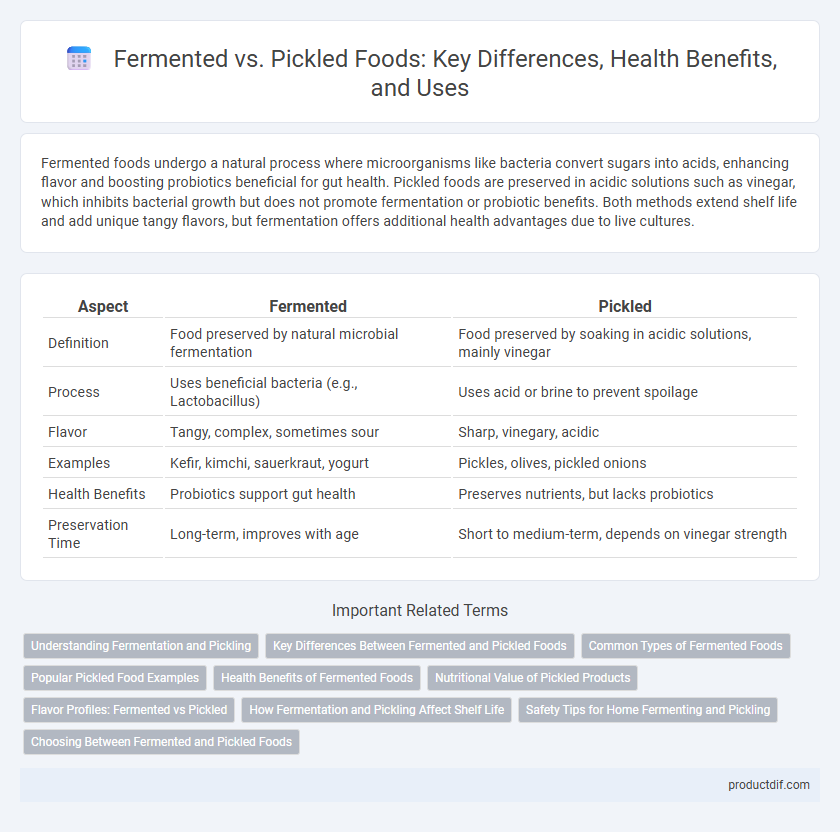Fermented foods undergo a natural process where microorganisms like bacteria convert sugars into acids, enhancing flavor and boosting probiotics beneficial for gut health. Pickled foods are preserved in acidic solutions such as vinegar, which inhibits bacterial growth but does not promote fermentation or probiotic benefits. Both methods extend shelf life and add unique tangy flavors, but fermentation offers additional health advantages due to live cultures.
Table of Comparison
| Aspect | Fermented | Pickled |
|---|---|---|
| Definition | Food preserved by natural microbial fermentation | Food preserved by soaking in acidic solutions, mainly vinegar |
| Process | Uses beneficial bacteria (e.g., Lactobacillus) | Uses acid or brine to prevent spoilage |
| Flavor | Tangy, complex, sometimes sour | Sharp, vinegary, acidic |
| Examples | Kefir, kimchi, sauerkraut, yogurt | Pickles, olives, pickled onions |
| Health Benefits | Probiotics support gut health | Preserves nutrients, but lacks probiotics |
| Preservation Time | Long-term, improves with age | Short to medium-term, depends on vinegar strength |
Understanding Fermentation and Pickling
Fermentation is a natural metabolic process where microorganisms like bacteria and yeast convert sugars into acids, gases, or alcohol, enhancing food preservation and flavor complexity. Pickling involves preserving food in an acidic solution, typically vinegar or brine, creating a sour taste and extending shelf life without necessarily involving microbial activity. Both methods improve food safety and nutritional value but differ fundamentally in their biochemical mechanisms and resulting textures.
Key Differences Between Fermented and Pickled Foods
Fermented foods undergo a natural microbial process where beneficial bacteria convert sugars into acids or alcohol, enhancing probiotics and nutritional value. Pickled foods are preserved in an acidic solution, often vinegar, which halts microbial activity to maintain texture and flavor without promoting probiotic growth. The key difference lies in fermentation relying on live bacterial cultures for preservation, while pickling uses acid or brine as a chemical preservative.
Common Types of Fermented Foods
Common types of fermented foods include yogurt, kimchi, sauerkraut, miso, and kombucha, each rich in beneficial probiotics that enhance gut health. These foods undergo natural microbial fermentation, transforming sugars into acids or alcohol, which preserves the food and develops complex flavors. Unlike pickled foods that primarily use vinegar, fermented foods rely on live cultures for natural preservation and nutritional benefits.
Popular Pickled Food Examples
Popular pickled foods include cucumbers, known as pickles, sauerkraut made from fermented cabbage, and kimchi, a spicy fermented Korean vegetable dish. These foods are rich in probiotics, which promote gut health and enhance digestion. Pickling preserves food by soaking it in vinegar or brine, creating a tangy flavor distinct from fermentation's natural bacterial action.
Health Benefits of Fermented Foods
Fermented foods contain beneficial probiotics that enhance gut health by promoting a balanced microbiome and improving digestion. These foods, such as yogurt, kimchi, and sauerkraut, provide essential nutrients and antioxidants that support the immune system. Unlike pickled foods, which are typically preserved in vinegar, fermentation naturally produces enzymes and vitamins that aid nutrient absorption and reduce inflammation.
Nutritional Value of Pickled Products
Pickled products retain essential nutrients such as vitamins A, C, and K while offering antioxidants that support immune health. The vinegar or brine used in pickling helps preserve minerals like calcium and potassium, contributing to electrolyte balance. Unlike fermentation, pickling does not significantly boost probiotic content but provides a range of preserved nutrients beneficial for a balanced diet.
Flavor Profiles: Fermented vs Pickled
Fermented foods develop complex, tangy flavors through natural microbial activity, creating notes of umami and slight sourness that evolve over time. Pickled foods, immersed in vinegar or brine, offer sharp, straightforward acidity with a crisp, bright taste. Fermentation enhances depth and aroma, while pickling emphasizes a clean, consistent tartness.
How Fermentation and Pickling Affect Shelf Life
Fermentation extends shelf life by promoting the growth of beneficial bacteria that produce natural preservatives like lactic acid, which inhibits spoilage microorganisms. Pickling preserves food through an acidic environment created by vinegar or brine, effectively preventing bacterial growth and decay. Both methods enhance durability, but fermentation often improves nutritional value, while pickling primarily focuses on preservation and flavor.
Safety Tips for Home Fermenting and Pickling
Home fermenting and pickling require strict hygiene practices to prevent harmful bacteria growth; always use clean, sterilized jars and utensils. Maintain proper salt concentrations and acidity levels to inhibit pathogenic microorganisms, ensuring safe preservation. Store fermented and pickled foods in cool, dark environments and regularly check for signs of mold or off-odors to avoid foodborne illnesses.
Choosing Between Fermented and Pickled Foods
Choosing between fermented and pickled foods depends on desired health benefits and flavor profiles. Fermented foods like kimchi and sauerkraut offer probiotics that support gut health through live beneficial bacteria, while pickled foods provide a tangy taste with preservation benefits due to vinegar or brine but lack live cultures. Understanding the nutritional differences helps in selecting foods that enhance digestion or add acidity to meals.
Fermented vs Pickled Infographic

 productdif.com
productdif.com